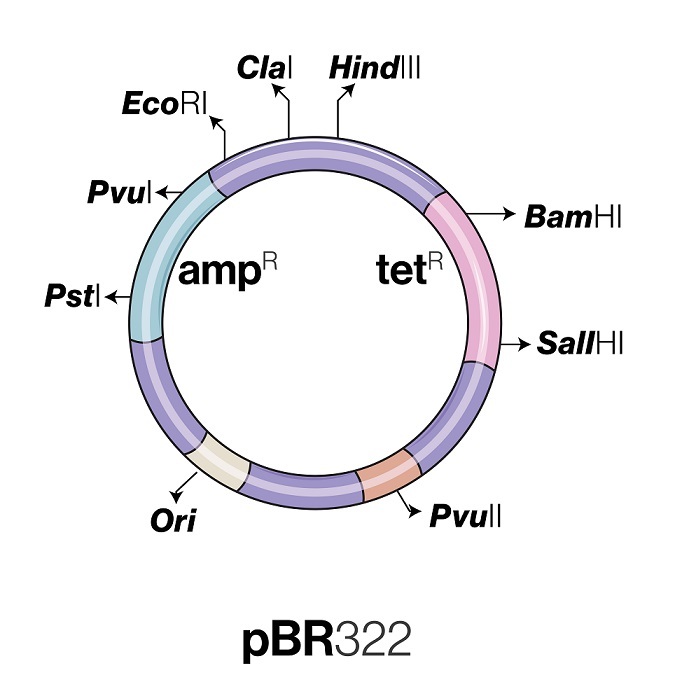
 Data Structure
Data Structure Networking
Networking RDBMS
RDBMS Operating System
Operating System Java
Java MS Excel
MS Excel iOS
iOS HTML
HTML CSS
CSS Android
Android Python
Python C Programming
C Programming C++
C++ C#
C# MongoDB
MongoDB MySQL
MySQL Javascript
Javascript PHP
PHP
- Selected Reading
- UPSC IAS Exams Notes
- Developer's Best Practices
- Questions and Answers
- Effective Resume Writing
- HR Interview Questions
- Computer Glossary
- Who is Who
pBR322 Vector: Definition, structure, and Applications
Introduction
The pBR322 vector is a plasmid vector that has been extensively used in genetic engineering and molecular biology research for over four decades.  It was one of the first plasmids to be commercially available and has since become a widely used tool in recombinant DNA technology. In this article, we will explore the structure, features, and applications of the pBR322 vector.
It was one of the first plasmids to be commercially available and has since become a widely used tool in recombinant DNA technology. In this article, we will explore the structure, features, and applications of the pBR322 vector.
Definition
The pBR322 vector is a circular double-stranded DNA molecule that is approximately 4361 base pairs long. It is an E. coli plasmid that was first constructed in 1977 by Bolivar and Rodriguez, and it is named after its creators. The pBR322 vector has a unique combination of antibiotic resistance genes, restriction enzyme sites, and other important features that make it an ideal tool for genetic engineering.
Structure
The pBR322 vector has a complex structure that consists of several key elements. The plasmid contains two origins of replication, which allow it to replicate in both E. coli and other bacterial hosts. It also has two antibiotic resistance genes, one for ampicillin and one for tetracycline, which allow researchers to select for cells that have taken up the plasmid.
The pBR322 vector also contains multiple unique restriction enzyme sites, including EcoRI, PstI, HindIII, and SalI. These restriction enzyme sites allow researchers to cut the plasmid at specific locations, which is essential for cloning and other molecular biology techniques.
Applications
The pBR322 vector has a wide range of applications in molecular biology and genetic engineering. Some of the most common applications of the pBR322 vector include ?
Cloning
The pBR322 vector is a popular tool for cloning because it contains multiple unique restriction enzyme sites. Researchers can cut the plasmid at specific locations and insert a foreign DNA fragment into the plasmid. This process allows for the easy cloning of genes or DNA sequences of interest.
Gene Expression
The pBR322 vector can be used to express genes in a host cell. Researchers can insert a foreign gene into the plasmid and use the vector's promoter to drive gene expression. This process allows for the production of large quantities of recombinant protein.
Site-directed Mutagenesis
The pBR322 vector can also be used for site-directed mutagenesis, a technique that allows researchers to introduce specific mutations into a gene of interest. This technique involves cutting the plasmid at specific locations and inserting a modified DNA fragment into the plasmid.
Antibiotic Resistance
The pBR322 vector's antibiotic resistance genes can be used to select for cells that have taken up the plasmid. This feature is essential for identifying cells that contain the desired DNA sequence or gene of interest.
Conclusion
The pBR322 vector is an essential tool in molecular biology and genetic engineering. Its unique combination of antibiotic resistance genes, restriction enzyme sites, and other important features make it an ideal tool for cloning, gene expression, site-directed mutagenesis, and antibiotic resistance selection. Its versatility and ease of use have made it a staple of genetic engineering and molecular biology research for over four decades.
FAQs
Q1. What is the pBR322 vector used for?
Ans. The pBR322 vector is used for a wide range of applications in molecular biology and genetic engineering, including cloning, gene expression, site-directed mutagenesis, and antibiotic resistance selection.
Q2. What is the structure of the pBR322 vector?
Ans. The pBR322 vector is a circular double-stranded DNA molecule that is approximately 4361 base pairs long. It contains two origins of replication, two antibiotic resistance genes, and multiple unique restriction enzyme sites.
Q3. Who created the pBR322 vector?
Ans. The pBR322 vector was first constructed in 1977 by Bolivar and Rodriguez, and it is named after its creators.
Q4. What are the antibiotic resistance genes present in the pBR322 vector?
Ans. The pBR322 vector contains two antibiotic resistance genes, one for ampicillin and one for tetracycline.
Q5. What is site-directed mutagenesis?
Ans. Site-directed mutagenesis is a technique that allows researchers to introduce specific mutations into a gene of interest. This technique involves cutting the plasmid at specific locations and inserting a modified DNA fragment into the plasmid.
Q6. What are the advantages of using the pBR322 vector?
Ans. The pBR322 vector is an essential tool in molecular biology and genetic engineering due to its unique combination of antibiotic resistance genes, restriction enzyme sites, and other important features. Its versatility and ease of use have made it a staple of genetic engineering and molecular biology research for over four decades.
Q7. How does the pBR322 vector allow for antibiotic resistance selection?
Ans. The pBR322 vector's antibiotic resistance genes can be used to select for cells that have taken up the plasmid. This feature is essential for identifying cells that contain the desired DNA sequence or gene of interest.
Q8. What are some common applications of the pBR322 vector?
Ans. Some common applications of the pBR322 vector include cloning, gene expression, site-directed mutagenesis, and antibiotic resistance selection.

